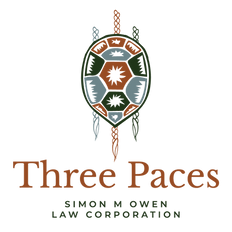“Legal pluralism denotes a situation where two or more legal systems coexist in the same social field… [But] if reconciliation is to be symmetrical… Indigenous law [must] relate to state law without assuming inferiority” – Professor Val Napoleon, IPC (Indigenous Peoples’ Counsel)
It’s looking like another good year for camas in Lək̓ʷəŋən territory. Purple petals with yellow stamens are beginning to flourish around the expressive gnarls of the Garry Oaks beloved of south Islanders. It’s a Renoir of colour, all happening in the remnant ‘wild’ meadows that, in reality, are visible evidence of the land’s long cultivation by Coast Salish kinships.
Camas shares its range with many other plants, but, in this season, blooms in sync with Spanish bluebells. These pretty flowers are (you guessed it) native to the Iberian Peninsula, but have firmly made a home here, growing abundantly in both so-called natural and so-called developed spaces. But I’ve never seen camas flowering on lands that have been dug up, fenced in, or otherwise “improved”.
Our current state of law seems a bit like this: an out-of-balance mix of recognitions, of parallel lands and lives where one perennial takes up more, while the other takes more on. Most, if not all, Indigenous folx in Canada are well-practiced legal pluralists. While bravely attending to their own, history’s crankshaft has forced them to navigate – in every way from defined or demeaned object to empowered participant (think Cabinet Minister, or Queen’s Representative) – the laws and legal institutions we’ve presumed to call Common. More consensually, many Indigenous people are legal pluralists by way of upholding relationships, responsibilities, and rights within kinships that connect and are accountable to different societies, diverse authorities.
But at the risk of being blunt, this is not a widely felt experience for too many on the other side of the meadow. Most non-Indigenous Canadians are not used to thinking or acting like we exist – who work, play, grow homes and families – in plural legal spaces (this despite our lives being simultaneously regulated by federal, provincial, and local levels of government).
If the pluralism that Indigenous people experience were equitable – if imported systems of law truly did coexist with – perhaps even benefit – the nourishing roots and brilliant blooms of Indigenous ones, instead of crowding their numbers and choking their functions – then us non-Indigenous folx would have much less work to do to realize the commitments we’ve made in the Declaration on the Rights of Indigenous Peoples Act (DRIPA). Indeed, we’d be better placed to perceive and learn from the vibrant examples of Indigenous legal pluralism in our efforts to reconfigure our own decision-making frameworks and foundations, especially when it comes to the small business of sustainably caring for the other-than-human world. Maybe camas might even, eventually, return to the places where we’ve planted lawns and legislatures.
As non-Indigenous allies, our job is not to pretend we know what’s best for the camas – Indigenous legal orders are strongly self-rooted and will healthily regrow in decolonized spaces. Rather, our concern is with the bluebell. Crown laws in this province need not be deracinated – in the inheritance of time, the fact is that we all belong. But what DRIPA requires, and what all of us must foster, is finding serious, sustainable, practical and measurable ways to enact our being here more responsibly, more reciprocally, more plurally. It is humbling, messy, necessary work. But done well, it is beautiful.


Comments